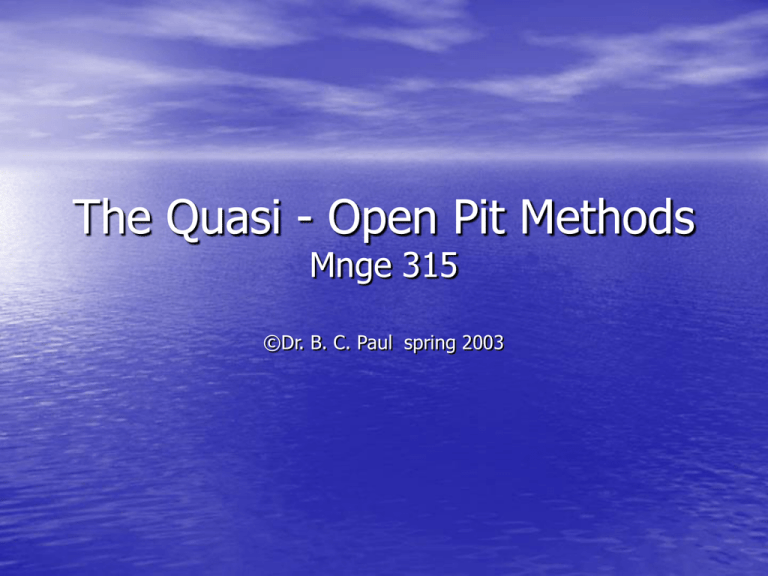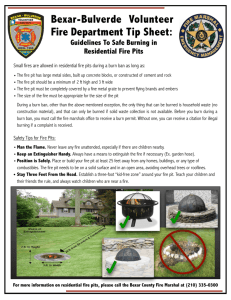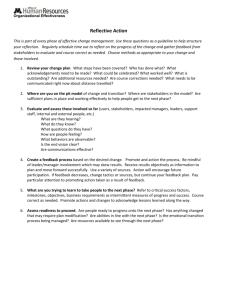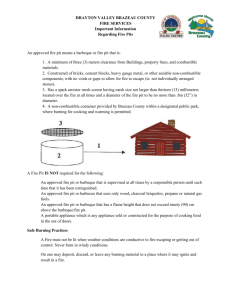Lecture 12 Open Pit Mine Variations
advertisement

The Quasi - Open Pit Methods Mnge 315 ©Dr. B. C. Paul spring 2003 Open Pit Sequence Flexibility • We have just gone over classic open pits than go down and push back in a variety of ways as it develops out to the ultimate pit. • Sometimes Site Specific constraints don’t allow open pits to be developed in any direction that economics chooses The Dipping Bed Example Even though this mine is too Steep to backfill as mining goes Down-dip, this mine must still Systematically move forward Advancing down-dip just like Your strip mine in Homework #3 You can still use Learch Grossman to find an Ultimate Pit But you have little choice on the sequence The Quarry – A Simple Case Overburden Soil and Degraded Rock Rock Layer #1 Rock Layer #2 Unique Geologic Characteristics – The ore zone is not a steeply dipping geometric Object, it is a bed. The ore spreads out in all directions. How far out you go is Likely to be determined by a property line, rather than the edge of an ore zone. A Simple Midwestern Quarry Overburden is limited – One way to improve net present value is to put off Stripping expenses. In a quarry there may be economies of scale in stripping All at once – and little to be gained by putting off stripping. Overburden Soil and Degraded Rock Rock Layer #1 Rock Layer #2 Ore Does Not Really Have a Grade – Most of the Rock Bed has about the same Value. Thus you optimize NPV by having more limited costs at first. Since rock Closest to surface usually has lower mining costs this suggests a top to bottom Sequence. High Rock Quality Overburden Soil and Degraded Rock Rock Layer #1 Rock Layer #2 May often use A bench height That matches Rock beds to Sort product Quality and characteristics Hydrothermal alteration often deposits valuable minerals in rock but it also makes It weak and fractured. Quarry rock is often strong and unfractured so it will Stand and steep angles and needs only narrow berms to catch a rare break-away Rock. Quarries can have Steep dipping Beds • Can end up with a pit that advances down dip • Can have thicker overburden – May end up with something like a strip mine where overburden from oneside backfills the pit on the other. Open Pit Mines • In some senses all forms of surface mines are open pits • Strip Mines tend to refer to coal operations with some very significant differences from open pits in the metal/ industrial mineral sense • Quarries also tend to be unique subset • Placer and dredge operations also unique subset Classic Open Pit • Characterized by a series of stair-step like • benches that each act as a working area Pit shapes tend to be more configured to geology of the deposit more than equipment needs/convenience – Many pits are ovals • Fits the geometry of disseminated metal deposits – Pits tend to be wider relative to length – Pits tend not to move like strip mine – pit develops in place Differences not Necessarily Simple • Working Benches were encountered in “Strip Mines” – Advance benches using trucks and shovels developing ahead of dragline – Multiple coal seams may need a bench for each – Contour haulback operations often had benches lined up with layers of concern – Mountain Top Removal can be developed as truck shovel benches • Local and Industry Specific Word Usage – Coal people like to “strip” mine – Metals/Industrial Minerals people like to “Open Pit” – Aggregate people like to Quarry Terrace Pit Mining Add Picture Note that all characterized by benches – often set up on truck shovel equipment Working heights. Can also be used with multi-seam coal mining Factors Controlling Terrace Pit • Bench Heights are often controlled by the digging height of the shovel – In past drill accuracy limits have been important • Benches often give more gradual over-all slope – Dragline highwall is mostly angle of repose – May need a specific bench width to provide working room – smaller over-all slope to highwall More Terrace Pit Control • Trucks and Shovels often control OB movement rather than draglines – Dragline has limited boom length – favors narrow pits – Trucks and Shovels need room for equipment to drive across without getting tangled up or caught on steep slope • Tends to favor wider pits • Need for ramps tends to favor shorter pits rather than having long moving range like dragline Dipping Thick Coal Seams • Common in Western part of U.S. for coal Mining on the Strike or the Dip • Area Strip mines – Dragline moves down the strike with pickup and dump sequence moving down dip – Conspicuously advances down dip Mining Down the Strike • Contour Haulback schemes – Overburden movement is along the strike Add picture Coal Terrace Pits • With relatively flat seam overburden moves across the dip • With steeper dip overburden movement tends to be down strike – Even possible to have full pit width developed at once with contour mine like advance Evolving to True Open Pit • Benches advance down the dip • Pit length is limited for manageable network of truck haul roads • Overburden is not deposited in the same pit – Hauled to a distinct and separate pit along the strike – Phosphate Operations mine dipping phosphorous rich limestones that way Note the Distinct Feature • Pit is developed out to its stripping ratio limit leaving the pit open the entire time – Only at end of the pit life is the pit backfilled • Geometry and Equipment limitations in hardrock and industrial minerals defies a workable concurrent reclamation in the SMCRA sense – One reasons the law was only applied to coal






